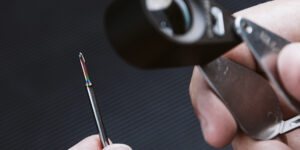Thermal Spray, Laser Cladding and Integration
Not only have robots kept St. Louis Metallizing at the top of the thermal spraying and laser cladding industry, but their expertise has now become so deep that they are starting to be an integrator of ABB robots for other end users.
Posted: November 26, 2012
Not only have robots kept SLM at the top of the thermal spraying and laser cladding industry, but their expertise has now become so deep that they are starting to be an integrator of robots for other end users.
Thermal spraying is a process where wire or powder is melted by a flame or electricity and sprayed onto a workpiece. During the process, the spray torch makes successive passes across the workpiece to produce layers of coating. Laser cladding is a metal surface enhancing process that applies a powdered metal material onto the base surface with a laser to ensure a metallurgical bond with minimal dilution and a thin heat affected zone.
Laser clad materials are ideal for withstanding the highly corrosive and erosive environments, particularly those found in the Oil and Gas industry. These applications are highly precise work, with multiple coating layers of exacting thickness’ required to achieve the optimal protection and to meet stringent quality requirements, such as the AS9100/NADCAP standards covering aerospace parts.
Industrial robots have proven themselves to be uniquely capable of providing the precision and exacting repeatability that are critical to delivering the consistent part coverage required for the spraying processes to be effective.
St. Louis Metallizing (SLM; St. Louis, MO) has been applying metal and ceramic coatings to a wide variety of OEM and repair parts and machine components to minimize corrosion and extend part life for over 60 years. The company applies thermal spray and laser cladding to parts that vary greatly in complexity and size, from small aerospace parts and valves used in the oil and gas industry, to 40 ft long hydraulic rods for large mining vehicles.
SLM must handle the demands of a diverse configuration of component parts, ranging from jet engine parts and landing gear of varying sizes for aerospace applications, to pumps and valves with wear surfaces that erode/corrode in oil and gas applications, to large power plant turbine components, to processing large rolls, crankshafts and liners for general industry.
For much of its history, the factory applied the coatings through a manual spray process. But as its market grew to handling parts from throughout North America and abroad, the company began to evaluate the effectiveness of automation and, in 1989, purchased a Cincinnati Milacron Model 646 6-axis robot to apply the coatings on larger parts.
Just a year later, ABB Robotics North America (Auburn Hills, MI) bought the Cincinnati Milacron industrial robot business. Pleased by the results of its initial foray into robots, SLM built up a portfolio of 17 ABB robots of varying models in its St. Louis facility to handle the coating of parts of all shapes and sizes. The SLM robot inventory now includes five IRB 6400, four IRB 4600 and five IRB 2400 models, as well as earlier versions of some of these models.














